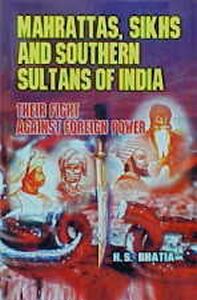
Contents: Preface. Hindu dynasties. Muslim dynasties. 1. Shivaji and the rise of Marathas : conception of a Hindu empire. 2. Personal traits of Mahratta Brahman princes. 3. Life under the Mahrattas: i). Constitutional, administrative and customary institutions. ii). Caste regulations under Maratha rule. 4. The Maratha justice: i). Early Hindu justice. ii). Ayya Shastri. 5. The ‘National’ character of the ‘historical’ Marathas. 6. The Mahrattas and the Sikhs: i). Maratha-Sikh rivalry in Haryana. ii). Marathas and Maharaja Ranjit Singh. 7. Anglo-Mahratta wars: i). Origin of the first Anglo-Maratha war. ii). The second Anglo-Maratha war and mewar. 8. Sovereignty of the sea as practised in the Maratha period. 9. Maratha arms. 10. Sultans of South India. 11. Government and administrative system of Tipu Sultan. 12. The Virtuous Sultan: i). Moral laws under Tipu Sultan. ii). Tipu Sultan and his English prisoners of war. iii). Tippu’s endowments to the Hindus and the Hindu institutions. 13. The rise and fall of the Dutch in India. 14. Making of a Jat Kingdom. 15. Rebels turned rulers: 1. Sikh-Mughal struggle. ii). Character of the Sikhs of the eighteenth century. iii). When a Sikh general occupied the Delhi Throne. 16. Life and times of Ranjit Singh. 17. Military system of the Sikhs: i). Army organisation, administration and tactics. ii). Zafar Nama--a manual of military training. iii). European military officers of Lahore Durbar. 18. Judicial system of Maharaja Ranjit Singh. 19. Trans-Himalayan campaigns of General Zorawar Singh. 20. Anglo-Sikh wars. Select bibliography. Index.
"This book deals with comparatively shortlived kings and kingdoms--Mahrattas, Southern Sultans, Sikhs and Jats who fired by patriotic sentiments and fighting heroically against heavy odds dislodged foreign government but not long afterwards were replaced by another foreign power.
It is a curious fact of history that just as Shivaji whose ‘Conception of a Hindu Empire’ was unfailing and Aurangzeb between them created the history of the latter half of the seventeenth century, so did to some extent before them their fathers also in the earlier part of the century. Shahji (1594-1664) and Shah Jahan (1592-1666), contemporaries in age and activity, play a game which was later continued by their sons. Their grandfathers Jahangir and Maloji were the first to find themselves in opposition.
Conflict between the Sikhs and Mughal’s tyrannical forces was rather long-drawn involving a number of human sacrifices. The Punjab bore the brunt of several invasions for ages with heavy loss of life and property. India has a defensive culture of waiting for aggressors, allowing them space and fighting every battle on Indian soil. But Maharaja Ranjit Singh was the only Indian who had strategic sense. To defend Punjab he build up his borders in Afghanistan. He stemmed the tide of brutal attacks and established a true cosmopolitan state. The Anglo-Mahratta and Anglo-Sikh wars sealed the fate of both empires. The spectacular rise of Tipu Sultan in the South India clashed with the English military power and met the same fate.
After Aurangzeb’s death, the decline and decay of the Mughal Empire was rapid. So was the rise of Jats who created out of nothing a large Kingdom in the heart of India under the leadership of Maharaja Suraj Mal. He is to the Jats what Shivaji to the Mahrattas and Maharaja Ranjit Singh is to the Sikhs. With his death, the kingdom also ended.
There has been no history on ‘The Rise and fall of the Dutch in India’. This book includes a research and comprehensive article on this short-lived power.
Superiority of armament may increase the chances of success in war. It is a great element of success." (jacket)
